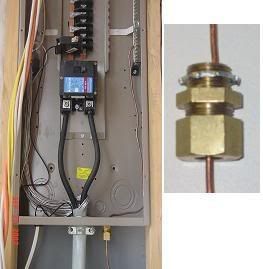I think we are over thinking this and mixing up what current that will flow through this screw.
First most of these screws are about a #10, and about a couple of inch's long, the impedance of such a short screw is very low, also the only current that should ever flow through that screw is a ground fault, because the code requires that the grounding electrode conductors are to be landed on the neutral bar unless the grounding bar is connected to the neutral by a wire or bus bar.
Majority of a lightning strike will flow on other paths in a building so very little will ever flow across that screw, most will follow the water pipe and gas piping in a building and believe it or not many times it Will follow cable and phone lines.
As for fault current it is such a fast duration that it will never come close to enough heat to damage the connection because the current is much higher in a ground fault that the breaker open very fast, this is one of the reasons why when sizing grounding conductors from table 250.122 the size is much smaller then the current carrying conductors.
As for over loads, you should not have any normal current on the grounding as your current should be hot to hot, or hot to neutral.
In a proper installation that little screw will fault thousands of amps without any damage as long as the breaker opens like it should and the screw has been tightened to the requirements of the manufacture.
Ever open a re-linkable fuse and see how small the aluminum element is on a hundred amp fuse.
Also the fact that fault current really has nothing to do with the size of the main breaker, as it is possible to have a higher fault current on a 100 amp service that is close to the transformer then a 200 that is away from a transformer, much of the amount of fault current will depend upon the impedance of the path to the source, this is where understanding more about electrical theory is so important, on a dwelling service where there in no coordination of the breakers you could have a fault on a 30 amp circuit that will open both the 30 amp breaker and the 200 amp main, because both can have the same instantaneous fault current time curves that will present the same level of fault to both and if it exceeds both trip curves it will open both, this is an example of that current will always be equal in a series circuit.

